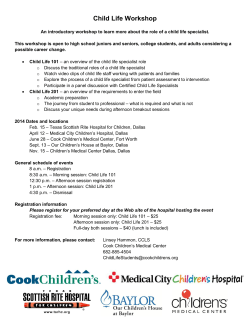
Communication versus knowledge translation: What's the difference INTRODUCTION KT AND COMMUNICATIONS
poster6.pdf 1 26/01/2014 11:29 Communication versus knowledge translation: What's the difference Tamika Heiden, PhD - @ktaustralia Knowledge Translation Australia INTRODUCTION KT AND COMMUNICATIONS This poster is intended to present an overview of communications and knowledge translation. The aim is to clarify the role of KT and where communication fits in the KT process. It is expected that this topic will raise new questions about the differences and similarities between and across the roles of the communication specialist and the KT specialist. The role of the KT specialist includes many skills including but not limited to: Understanding and communicating the goals and perspectives of researchers, and practitioners; expanding links with the community; meeting with agencies build strong partnerships; providing unique solutions to develop and implement program or policy changes; developing plain language summaries; maintaining website content and promotional materials; researching grant opportunities; developing KT plans for grant applications. WHAT IS KNOWLEDGE TRANSLATION (KT)? KT is the science of working to bridge the gap between what we know and what we do. Historically, KT can be traced to the field of agriculture at the beginning of the 20th century5. In the 1990’s the United States government added KT requirements to its research funding, and in the year 2000 the Canadian Government formalised the requirement for KT. KT is defined as: "The synthesis, exchange, and application of knowledge by relevant stakeholders to accelerate the benefits of global and local innovation in strengthening health systems and improving people’s health." World Health Organization (2005) CHARACTERISTICS OF KT C M Y CM MY CY CMY K KT is characterised by the following processes7 • KT includes all steps between the creation of new knowledge and its application. • KT needs multidirectional communications. • KT is an interactive process. • KT requires ongoing collaborations among relevant parties. • KT includes multiple activities. • KT is a nonlinear process. • KT emphasizes the use of research-generated knowledge (that may be used in conjunction with other types of knowledge). • KT involves diverse knowledge-user groups. • KT is user- and context-specific. • KT is impact-oriented. • KT is an interdisciplinary process. WHAT IS COMMUNICATION? Communication is a skill and a profession. The definition of communication often suggests a one way interaction or push of information as follows: “Communication is the activity of conveying information through the exchange of thoughts, messages, or information, as by speech, visuals, signals, writing, or behavior. It is the meaningful exchange of information between two or more living creatures.” Wikipedia (Accessed 20 Jan 2014) Alternatively, communication has been given a more dynamic definition: “Two-way process of reaching mutual understanding, in which participants not only exchange information, news, ideas and feelings but also create and share meaning. In general, communication is a means of connecting people or places.” www.businessdictionary.com (Accessed 20 Jan 2014) USING KNOWLEDGE FROM RESEARCH FINDINGS: Within the KT profession there is an ongoing debate over the role of the communication specialist and the KT specialist 1-4. The debate has shown that the intersection of these two roles can vary depending on skills, specific job roles and functions, and personal views. The introduction of institutional capacity for KT specialists’ has provided an opportunity to lend clarity to the roles of the communication specialist and of the KT specialist. My aim is to start a dialogue and gain clarity for both specialists which will focus on the roles and responsibilities/skills rather than job title. An adapted global KT model from the Canadian Institute of Health Research, based on the research cycle, is used here to examine the role of the communication specialist within the KT process. The model shown below respresents knowledge creation through research (blue circles), the use of that knowledge (green circles), and communication of the knowledge (red circle). The tasks, and roles involved, for each of these functions, are outlined further. Dissemination of Knowledge Creation of questions and methods Researchers and knowledge users Impacts & evaluation Research process Implementation /application of knowledge Knowledge from research findings implications/ context of knowledge KNOWLEDGE CREATION: Tasks involved Roles/expertise Grant writing KT specialist Developing KT plans Knowledge broker, relationship manager, researchers Broker relationships with partners/stakeholders Knowledge broker, researchers, stakeholders Co-production of relevant questions – researchers and stakeholders Researchers Literature and previous research Research process Researchers Stakeholder feedback and continued engagement Tasks involved 1. Work with stakeholders to put new knowledge in context. Determine how knowledge could make a difference Roles/expertise Stakeholders, researchers, KT specialist, knowledge broker* 2. Apply the knowledge Commercialisation, guidelines, clinical practice, service provision, policy Stakeholders, researchers, implementation scientists, KT specialist 3. Evaluate the implementation and influence subsequent research Researchers, stakeholders, implementation scientists, evaluation experts 4. Communicate the impacts of our research/implementation Communications specialist, researchers Note: * Knowledge broker may be required if new relationships and stakeholders required. DISSEMINATION OF KNOWLEDGE: Tasks involved Roles/expertise Conference presentations Researcher, communications Peer reviewed publications Researchers Plain language summaries Researchers, communications specialist Public seminars Communications specialists, researchers, stakeholders Social Media Researchers, communication specialists Stakeholder feedback Researchers, KT specialist, communication specialist CONCLUSION KT Australia, through the use of this model, has shown that knowledge translation involves many key skills, of which communication is a component essential to the success of any KT strategy. KT specialists routinely utilise additional skills, knowledge, and roles to bridge the research to practice gap. KT is a complex process requiring the connection of users and producers of knowledge to co-create new knowledge products to serve their needs. This process is facilitated using numerous skill sets that may or may not be within a single person or role. This process differentiates the role of the KT specialist from communication professional and outlines the skills required for successful KT, rather than the job title. Importantly, it is in working with multiple skill sets, expertise, and professions that the KT cycle can be successful. The KT Australia Model allows individuals and institutions to recognise the required expertise needed for successful KT relationships and outcomes, and to tailor an appropriate team for their needs REFERENCES 1. 2. Researchers, specialist staff within research institute or team, communications specialist 3. 4. 5. 6. 7. Phipps, D. (2013). [Linkedin – Research Impact Group] Knowledge mobilization vs Communications. Message posted to http://www.linkedin.com/groups/Knowledge-mobilization-vs-Communications-1969705.S.232135149?qid=a893990d-379e-43e9-9599-e7f26cd65610&trk=groups_items_see_more-0-b-ttl&_mSplash=1 Phipps, D. (2013). [Linkedin – Research Impact Group] Knowledge Mobilization and Communications. Message posted to http://www.linkedin.com/groups/Knowledge-Mobilization-Communications-1969705.S.5800556207076814849?qid=6444d6c0-278d-42d0-ade7-f75c4ab8c68c&trk=groups_items_see_more-0-b-ttl Johnny, M. (2013, May 29). Knowledge Mobilization and Communications / La mobilisation des connaissances et la communication, [Wordpress blog], posted to http://researchimpact.wordpress.com/2013/05/29/knowledge-mobilization-and-communications-la-mobilisation-des-connaissances-et-la-communication/ Levesque, P. (2010, December 9). What is the difference between communications, knowledge transfer, and marketing? [Online forum] posted to http://www.knowledgemobilization.net/archives/383 Research Into Action - A Knowledge Translation Initiative (n.d). History of Knowledge Translation. www.ktexchange.org (Retrieved 20 Jan 2014) Graham ID, Logan J, Harrison MB. Straus SE, Tetroe J, Caswell W, Robinson N. Lost in Knowledge Translation: Time For A Map? J Contin Educ Health Prof 2006; 26(1): 13. Sudsawad, P. (2007). Knowledge translation: Introduction to models, strategies, and measures. Austin, TX: Southwest Educational Development Laboratory, National Center for the Dissemination of Disability Research.
© Copyright 2025





















